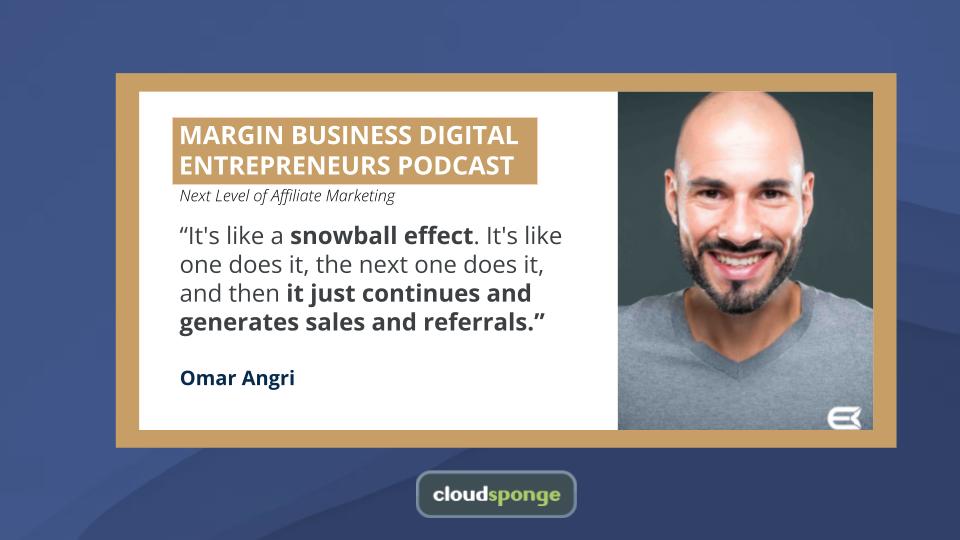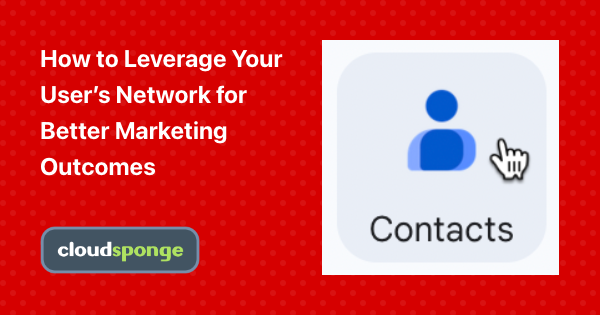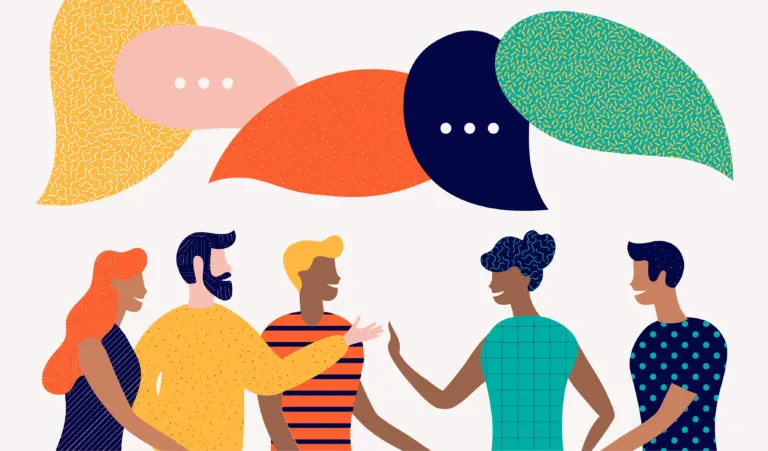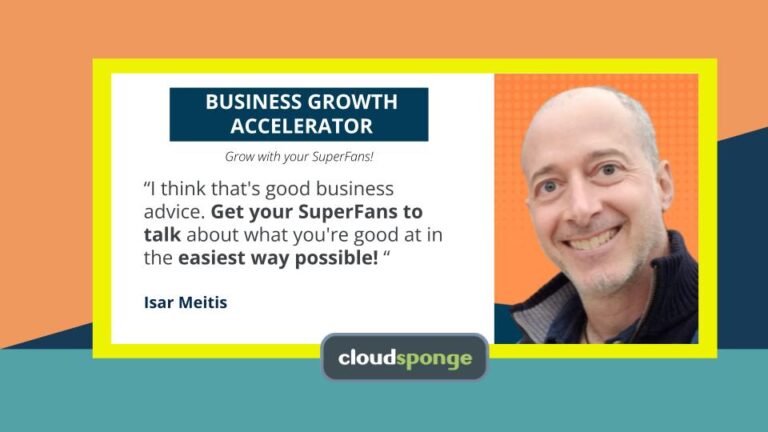
Omar Angri, the host of Margin Business Digital Entrepreneurs Podcast in conversation with our CEO, Jay Gibb, explores how a contact picker can be leveraged to grow via affiliate marketing.
Via anecdotal evidence from CloudSponge customers such as Stitch Fix, JustFab, and many more – discover just how a single button can be game-changing when growing an e-commerce business via word-of-mouth marketing.
Double the performance of your referral programs in 3 easy steps Download our DIY Workbook today
Podcast Transcript
Omar Angri:
So yeah, welcome to the Margin Business Digital Entrepreneur podcast. Today’s guest is Jay Gibb. Jay is a former software engineer and the founder and CEO of B2B SaaS company, CloudSponge. Together with this team, Jay helped numerous agencies, helped their e-commerce store customers optimize their word-to-mouth sales in 2010. With a unique blend of tech expertise and soft skills, Jay is an expert at helping e-commerce stores to build the right futures to reduce customer acquisition cost and increase sales. Welcome to the show, Jay. It’s really a pleasure having you here.
Jay Gibb:
Thank you very much for having me. It’s a pleasure to be here.
Omar Angri:
Please give us a little bit about your background, where you’re from and you know how you got into the e-commerce game, because you really … your kind of niche, I would even say, there is not too many people who are doing a correct job, let’s say it this way, because you cannot really … the crucial thing in this type of environment is that you cannot really prove the traffic you bring. But it’s really over time you can see what the impact actually is on your shop. So everyone wants to work with you. I’m a hundred percent sure of that because everyone who sells want to make more sales. So you found the right niche, actually. So please give me a little bit of context about all of this.
Jay Gibb:
Sure. So about me, I grew up in Western Canada City called Calgary, and I went to technical college to learn how to be a software developer back in the mid-90s. And I’ve been in software one way or another since then, since basically the mid to late 90s. And around 2010 was when we launched the first version of CloudSponge. And at the time I didn’t know that I was getting into e-commerce. We built some software that was kind of abstract and universally useful, and then as people bought it and we met our customers and we did customer success, and we sort of looked at the way that our customers were using it, then we started to realize that what we had built is a piece of software that e-commerce is using and benefiting from.
And so I can’t say that it was a stroke of genius or anything. It was really a real typical story of scratching our own itch and building something that was obviously missing. And now, 12 years later, most of our clients that purchase this software, which is just a monthly SaaS tool, it’s a subscription you pay every month for, but the vast majority of them are e-commerce stores or sort of in the peripheral of e-commerce, so things that have some kind of e-commerce checkout process or referral programs and anything where word of mouth is important. So in addition to just regular e-commerce, we also dominate social networks because word of mouth is obviously very important in social networks to get the network to grow, and also in crowdfunding and fundraising, where getting your backers and your enthusiasts to spread the word and talk about your campaign with their friends and family is important. And so those are some spaces that we do really well. But e-commerce is … if I was to draw a pie chart of CloudSponge customers, e-commerce is well over half. It’s probably three-quarters of our customer base.
Omar Angri:
That’s already a good overview of what you’re doing. If we go back to 2010, obviously Wild West, everything is upside down. There is still go a lot going on Amazon Marketplace products left and right. Software, you could pull data as you wish. There were no real limits. From this time, the software … actually, it was there where the software was developed, right?
Jay Gibb:
Yep.
Omar Angri:
Okay. And then over the years, you just added a little bit, added a little bit, because you … it’s so funny when people are saying, “Yeah, let’s build a SaaS software.” It’s like, “Yeah, let’s do it.” And after one year, it’s like, “Oh, this doesn’t work. Oh, this doesn’t work.” And then you see three years later still … that’s what I’m always saying. You should not underestimate such a software because it comes from passion. It comes a long way and it comes from a lot of trying and running tests and it’s just not … what did you do in the meantime while you were developing that software? Did ever sell on e-commerce or have you done just consulting or was it from the beginning something you could run for the customers?
Jay Gibb:
Yeah, it was mostly consulting and software that we could operate and run. And maybe it would be helpful if I just describe what it is that the software does so that everybody is able to visualize it.
So what we sell primarily is called a Contact Picker. And so if you imagine your own e-commerce store, somewhere on that store, you’re going to have word-of-mouth features. So places where you’re trying to get your customers or your audience, whoever’s on your website to share either links to products or links to a referral program or sending coupons or sharing wishlists or other things where you’ve already got some functionality on every e-commerce store that exists for allowing your fans, the people that love your products and have their own networks, to be able to talk about it, to be able to share it, to tweet links and put Facebook posts with links to all that kind of stuff. You and everybody listening is familiar with various word-of-mouth features that are sort of the table stakes best practices for e-commerce stores.
And what CloudSponge does is it adds the ability for those features to include the user’s address book. That’s as simple as it is. And there are thousands of websites. Many, many of your audience may have seen this before, where the little envelope icon that nobody clicks on, the one that’s the mail to link that is everywhere. Or you may have seen a referral friend form that sends your unique referral code to your friends and you have to type in a separate list of email addresses. You have to remember your friend’s email addresses. And type them in to a field. And if you’re on a mobile device, you’re switching from the Safari app to the contacts app and it’s a terrible user experience. And because of that, most people don’t do it.
And so what CloudSponge provides is a little button that looks like an address book, and you can make it look however you make it look like. You can make it say ‘Add from Contact’ or ‘Select from your Address Book’. You can make the button look however you want. But when you click it opens up a menu that’s got a Google logo and a Yahoo and an outlook.com and the iCloud and all the logos of all the places on the internet where people store their contacts, right?
And so then they select one of those logos. Most people choose Google, but the rest of them are still relevant and non-zero amount of usage. But they select Google, they give permission to read their contacts, their address book, and then they get an alphabetized list. If they’re on their phone, they got a nice little … down the right margin, it’ll have the alphabet so they can tap on it and just your address book on your phone, except it’s inside an e-commerce website, inside a Safari browser, inside a Chrome browser on a phone or on desktop.
And then they can select whoever they want, search for them, basically make a recipient list inside the CloudSponge Contact Picker. And then when they say next or whatever the button label is, then they go back to the e-commerce website and all those email addresses are just populated for them. They didn’t have to type anything. They didn’t have to try to construct a separated list from memory or any of that stuff. It just comes from their address book.
And so that’s kind of where we live. That’s the real niche. It’s like a niche of a niche, it’s a thing. And that’s the place where we’re able to really make a big difference, because a lot of times e-commerce stores, especially the ones that are bigger, are starting to hit diminishing returns for ad spending and other kinds of ad customer acquisition tools. But they haven’t listened to your podcast, they haven’t discovered that the address book button is a thing that’s really easy to add.
And when they do that, then all those people, they can start to really thrive with referral programs and word of mouth features, like I said, sending coupons, sharing wishlists, the other kinds of functionality that otherwise is not either not performing well, like those little envelope icons, or they just haven’t done them because they know that the email input use case is really difficult for users. And so those are things that all of a sudden become priorities once they realize that the address book and giving users access to it on in the interface is such a game changer.
Double the performance of your referral programs in 3 easy steps Download our DIY Workbook today
Omar Angri:
I’m quite sure about that because everything we want is just something easy, because I would jump directly off if I say, “Oh no, I need to do this and that and then this and open that,” and that’s it. I’m already gone. So this is … I think the user experience and make it as easy as possible is the most important thing, what you have right now of … the customer experience is super important, that you do it as fast as possible.
I’m coming directly to one of the questions I would like to ask you, because e-commerce very eager to have always more customers, more sales, more traffic. How would be the best way to do that? Maybe you can explain a little bit your techniques as far as you are allowed to do it and don’t reveal any secrets here.
Jay Gibb:
No, I’m happy to reveal whatever I know. No secrets on my end. As far as that, what I’ve seen work very well. And just to be clear, right now I’m talking about my customers, right? Because I’m not an e-commerce store, but I serve thousands of them. And so our customer success team gets access to them and we help them and we consult with them, and we are able to, on an occasional basis take a look at how things are working and see the creativity that comes from some of these really successful stores and then incorporate that into my suggestions, right?
So what we see working, there’s two things that I think are the biggest. Several little ones, but I think the two big ones is first of all to have a referral program of some kind. E-commerce stores that don’t have a double-sided referral program should seriously consider trying it. I mean, maybe it won’t work for everybody. And what I mean for anybody who doesn’t know what I’m talking about, what I mean by a double-sided referral program is if, let’s say I’m on a t-shirt store and I know that Omar wears t-shirts and he’s going to love the quality of these, I’m going to … Omar and all of my friends, I’m going to refer it to Omar, but I’ll more likely to refer to 10 people or 20 people if there’s some benefit for me. But also I need to be able to give them a coupon or give them some benefit.
So most of the referral programs that you see will have a trigger that’s basically a reward for me, the referrer, when my friend actually does a transaction. So I don’t get any kind of reward if I just spam it out to a bunch of people that don’t do anything. But if I’m thoughtful and I send Omar a $10 off coupon with a nice personalized message, it says, “Hey Omar, this is Jay, your friend, you know me, and I think you’re going to love these t-shirts, you should check them out.” And then if he buys one, he gets his $10 off and then I get some kind of notification that says, “Hey Jay, your friend Omar bought a t-shirt. Thank you for sending them to us. Here’s $10 off your next purchase.”
So now you’re turning me into a loyal customer that’s going to buy more t-shirts because now I’ve got a coupon sitting there waiting for me to use, right? And I’m able to send out those coupons to people in a really personalized way, in a thoughtful way that is … it’s not guaranteed, obviously, but the conversion rate on something like that is going to be much higher than the conversion rate of me posting a link to my Facebook page or doing something that’s not like a actual direct outreach from me to a friend with some words that I’ve written for that friend, right?
Omar Angri:
Definitely. I mean, we are going already now into the tactics. So we are going from how to increase the traffic of customers, and now we are going into the tactics. You already said a few ways how to do it or how was the best way and explained this well very well. But in order to double … if somebody wants to double his sales and said, “Listen, I need to do this now and please help me, how can I double my sales right now?” Obviously with the word-to-mouth tactics at the moment, how would be the best way … I mean a part of what you just explained right now?
Jay Gibb:
So what we can help with is doubling the word-of-mouth component of your sales. Obviously we can’t promise that we can double your total number of sales for your store because we don’t know how you generate them. But what we’ve seen anecdotally from customers for 12 years now is that whatever sales they’re currently generating from word of mouth, from that sales channel, we can easily double it, usually a lot more than that. Doubling it is easy. The addition of an address book or a contact picker, and then some of the other stuff that we’ve got in our downloadable white paper that is kind of a playbook for word-of-mouth checklist and audit for any e-commerce store, and I can tell you how to get to that later.
Omar Angri:
Yes, please.
Jay Gibb:
So we’ve got this workbook, it’s like six pages long, and it kind of goes through the basic routine of what do you need to do to double your word of mouth. And obviously the contact picker is part of that. And the way that the math works out on that, the way that you can think about the doubling of it, is if you’ve got … let’s say you’ve got a form, like a referral form already. You’ve got some kind of referral program that exists on your website and probably half of your audience already does. Then you just look at how well it performs, how many successful conversions that referral program generates for you, and then you add a contact picker to just the interface. You just add that button I was explaining before with the address on it.
What ends up happening on average … obviously every story’s a little different, so give me a little leeway on this … but on average is only five to 10% of the people that use the referral program are going to actually click that button and use their address book, right? Because some people don’t know what it means. Some people aren’t comfortable sharing their address book. There’s going … you’re going to get one out of 20, maybe one out of 10 people actually using that address book button.
But those people, that five to 10%, are going to generate 50% of your total referrals because it’s so much easier for them to select their friends. Basically everybody that doesn’t use it will probably have the tenacity or the patients or the ambition to type in one or two email addresses, usually just one, and then that one email address may or may not convert. But the people that are actually your super fans, the ones that really love your product and really have a lot of friends that also are going to love your product, they’re not going to have the patience to type in all those email addresses. So that person can just say, “Oh, great. Thank you for letting me use my address book. Thank you for providing a contact picker.” They’ll do it and then they’ll use our contact picker to select 10 friends or 20 friends or 30 friends or however many friends.
And so what ends up happening is that a relatively small percentage of people that use the address book with the contact picker are actually going to generate … they’re the ones that will double your total number of successful conversions on the word of mouth program or on the referral program.
Omar Angri:
Okay. It’s like a snowball effect. It’s like one does it, the next one does it, and then it’s down the line. They all refer and it’s using this playbook and it just continues and continues and generates sales and referrals.
Jay Gibb:
It does have a tendency to build on itself. I think all word-of-mouth programs do, because what ends up happening is that if I’m referring my friends that I already know are going to love this product, and then those people that turn into other fans and they also get the same rewards if they do the same thing and it ends up being a multiplying effect over the long period of time, as long as the e-commerce store operator watches it and nurtures it and pays attention to. It’s not the kind of thing you can just forget about. You really need to consider it an important investment of time and cycles to optimize it, just anything else on the store. But those that do, it becomes a permanent part of their long-term business strategy. It’s a really important piece of the puzzle for all of our customers.
Omar Angri:
Oh, you definitely said something really good here, long term. This is as well something I’m trying to explain to a lot of customers. Long term, we need to …



